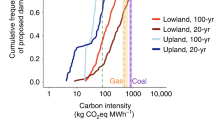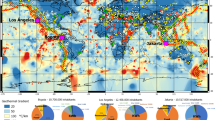Abstract
Already the largest generator of hydroelectricity, China is accelerating dam construction to increase the share of hydroelectricity in its primary energy mix to reduce greenhouse gas emissions. Here, we review the evidence on emissions of GHGs, particularly methane, from the Three Gorges Reservoir, and argue that although the hydroelectric reservoirs may release large amounts of methane, they contribute significantly to greenhouse gas reduction by substitution of thermal power generation in China. Nonetheless, more systematic monitoring and modelling studies on greenhouse gas emissions from representative reservoirs are necessary to better understand the climate impact of hydropower development in China.
This is a preview of subscription content, access via your institution
Access options
Subscribe to this journal
Receive 12 print issues and online access
$209.00 per year
only $17.42 per issue
Buy this article
- Purchase on Springer Link
- Instant access to full article PDF
Prices may be subject to local taxes which are calculated during checkout



Similar content being viewed by others
References
2011 National Electric Power Industry Statistics (China Electricity Council, 2012).
Michaelowa, A. Rule Consistency of Grid Emission Factors Published by CDM Host Country Authorities (CDM Watch, 2011).
Cheng, H., Hu, Y. & Zhao, J. Meeting China's water shortage crisis: Current practices and challenges. Environ. Sci. Technol. 43, 240–244 (2009).
Li, S. China's huge investment on water facilities: An effective adaptation to climate change, natural disasters, and food security. Nat. Hazards 61, 1473–1475 (2012).
Galy-Lacaux, C., Delmas, R., Kouadio, G., Richard, S. & Gosse, P. Long-term greenhouse gas emissions from hydroelectric reservoirs in tropical forest regions. Glob. Biogeochem. Cycles 13, 503–517 (1999).
Abril, G. et al. Carbon dioxide and methane emissions and the carbon budget of a 10-year old tropical reservoir (Petit Saut, French Guiana). Glob. Biogeochem. Cycles 19, GB4007 (2005).
Tremblay, A., Varfalvy, L., Roehm, C. & Garneau, M. (eds) Greenhouse Gas Emissions: Fluxes and Processes, Hydroelectric Reservoirs and Natural Environments (Springer, 2005).
Barros, N. et al. Carbon emission from hydroelectric reservoirs linked to reservoir age and latitude. Nature Geosci. 4, 593–596 (2011).
Fearnside, P. M. & Pueyo, S. Greenhouse-gas emissions from tropical dams. Nature Clim. Change 2, 382–384 (2012).
Ramos, F. M. et al. Methane stocks in tropical hydropower reservoirs as a potential energy source. Climatic Change 93, 1–13 (2009).
Makinen, K. & Khan, S. Policy considerations for greenhouse gas emissions from freshwater reservoirs. Water Alternatives 3, 91–105 (2010).
Kemenes, A., Forsberg, B. R. & Melack, J. M. Methane release below a tropical hydroelectric dam. Geophys. Res. Lett. 34, L12809 (2007).
Wehrli, B. Climate science: Renewable but not carbon-free. Nature Geosci. 4, 585–586 (2011).
Shindell, D. T., Faluvegi, G., Bell, N. & Schmidt, G. A. An emissions-based view of climate forcing by methane and tropospheric ozone. Geophys. Res. Lett. 32, L04803 (2005).
Lima, I. B. T., Ramos, F. M., Bambace, L. A. W. & Rosa, R. R. Methane emissions from large dams as renewable energy resources: A developing nation perspective. Mitig. Adapt. Strat. Glob. Change 13, 193–206 (2008).
Li, S. & Lu, X. X. Uncertainties of carbon emission from hydroelectric reservoirs. Nat. Hazards 62, 1343–1345 (2012).
Chen, H. et al. Methane emissions from newly created marshes in the drawdown area of the Three Gorges Reservoir. J. Geophys. Res. 114, D18301 (2009).
Chen, H. et al. Methane emissions from the surface of the Three Gorges Reservoir. J. Geophys. Res. 116, D21306 (2011).
Qiu, J. Chinese dam may be a methane menace. Nature News (29 December 2009); available via http://go.nature.com/Es4bow
Yang, L. et al. Spatial and temporal variation of methane concentrations in the atmosphere of the Three Gorges Reservoir and its relationship with methane emissions from the reservoir. Resour. Environ. Yangtze Basin 21, 209–214 (2012).
Yang, L. et al. Surface methane emissions from different land use types during various water levels in three major drawdown areas of the Three Gorges Reservoir. J. Geophys. Res. 117, D10109 (2012).
Wu, B., Chen, Y., Zeng, Y., Zhao, Y. & Yuan, C. Evaluation on effectiveness of carbon emission reduction of the power generation and shipping functions of the Three Gorges Reservoir. Resour. Environ. Yangtze Basin 20, 257–261 (2011).
Teodoru, C., Prairie, Y. & del Giorgio, P. Spatial heterogeneity of surface CO2 fluxes in a newly created Eastmain-1 reservoir in northern Quebec, Canada. Ecosystems 14, 28–46 (2010).
Lo, W. Modelling Greenhouse Gas Emissions from the Three Gorges Dam (Hong Kong Polytechnic Univ., 2009).
Zheng, H. et al. Spatial-temporal variations of methane emissions from the Ertan hydroelectric reservoir in southwest China. Hydrol. Process. 25, 1391–1396 (2011).
Specification for Reservoir Basin Cleaning Designing of Hydroelectric Project (DL/T5381–2007) (National Development and Reform Commission, 2007).
Fearnside, P. M. Do hydroelectric dams mitigate global warming? The case of Brazil's Curuá-una Dam. Mitig. Adapt. Strat. Glob. Change 10, 675–691 (2005).
Lu, F. et al. Preliminary report on methane emissions from the Three Gorges Reservoir in the summer drainage period. J. Environ. Sci. 23, 2029–2033 (2011).
Raadal, H. L., Gagnon, L., Modahl, I. S. & Hanssen, O. J. Life cycle greenhouse gas (GHG) emissions from the generation of wind and hydro power. Renew. Sustain. Energy Rev. 15, 3417–3422 (2011).
Bastviken, D. et al. Methane emissions from Pantanal, South America, during the low water season: Toward more comprehensive sampling. Environ. Sci. Technol. 44, 5450–5455 (2010).
Schubert, C. J., Diem, T. & Eugster, W. Methane emissions from a small wind shielded lake determined by eddy covariance, flux chambers, anchored funnels, and boundary model calculations: A comparison. Environ. Sci. Technol. 46, 4515–4522 (2012).
Roland, F. et al. Variability of carbon dioxide flux from tropical (Cerrado) hydroelectric reservoirs. Aquat. Sci. 72, 283–293 (2010).
Cheng, H. & Hu, Y. Improving China's water resources management for better adaptation to climate change. Climatic Change 112, 253–282 (2012).
Abe, D. S. et al. The effect of eutrophication on greenhouse gas emissions in three reservoirs of the Middle Tiete River, southeastern Brazil. Verh. Internat. Verein. Limnol. 30, 822–825 (2009).
Pittock, J. Better management of hydropower in an era of climate change. Water Alternatives 3, 444–452 (2010).
Acknowledgements
This study is supported by the Natural Science Foundation of China (Grant Nos 41202251, 41073079 and 41121063), and the Chinese Academy of Sciences (One Hundred Talents and Interdisciplinary Collaboration Team programs). This is contribution No. IS-1602 from GIGCAS.
Author information
Authors and Affiliations
Contributions
Both authors contributed equally to this work.
Corresponding author
Ethics declarations
Competing interests
The authors declare no competing financial interests.
Rights and permissions
About this article
Cite this article
Hu, Y., Cheng, H. The urgency of assessing the greenhouse gas budgets of hydroelectric reservoirs in China. Nature Clim Change 3, 708–712 (2013). https://doi.org/10.1038/nclimate1831
Received:
Accepted:
Published:
Issue Date:
DOI: https://doi.org/10.1038/nclimate1831
This article is cited by
-
Changing temporal and spatial patterns of methane emission from rivers by reservoir dams: a review
Environmental Science and Pollution Research (2023)
-
Sediment and Nutrient Trapping by River Dams: A Critical Review Based on 15-Year Big Data
Current Pollution Reports (2023)
-
High-resolution monitoring of inland water bodies across China in long time series and water resource changes
Environment, Development and Sustainability (2021)
-
River dam impacts on biogeochemical cycling
Nature Reviews Earth & Environment (2020)
-
Displacement efficiency of alternative energy and trans-provincial imported electricity in China
Nature Communications (2017)



